JEEP CHEROKEE 2016 KL / 5.G User Guide
Manufacturer: JEEP, Model Year: 2016, Model line: CHEROKEE, Model: JEEP CHEROKEE 2016 KL / 5.GPages: 236, PDF Size: 11.24 MB
Page 191 of 236
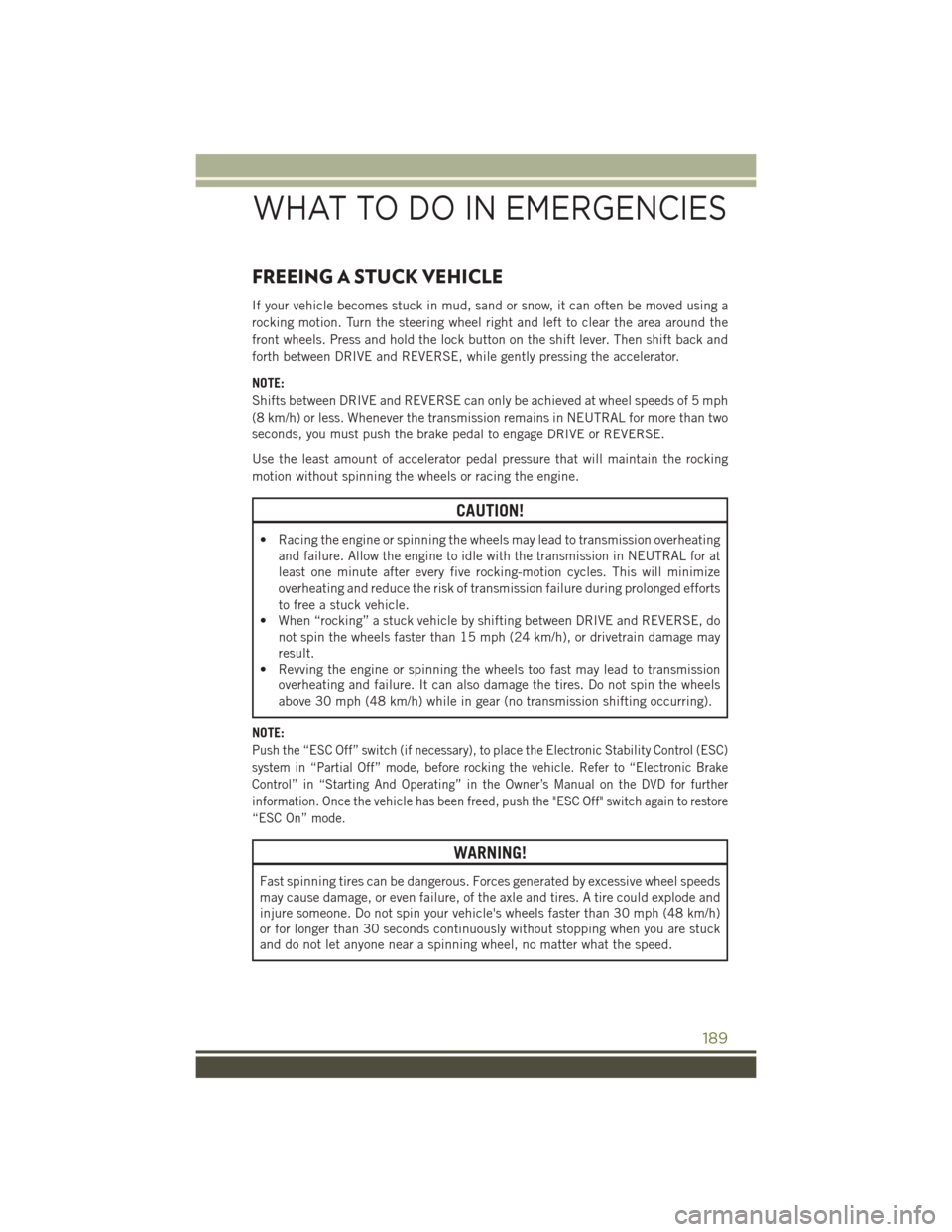
FREEING A STUCK VEHICLE
If your vehicle becomes stuck in mud, sand or snow, it can often be moved using a
rocking motion. Turn the steering wheel right and left to clear the area around the
front wheels. Press and hold the lock button on the shift lever. Then shift back and
forth between DRIVE and REVERSE, while gently pressing the accelerator.
NOTE:
Shifts between DRIVE and REVERSE can only be achieved at wheel speeds of 5 mph
(8 km/h) or less. Whenever the transmission remains in NEUTRAL for more than two
seconds, you must push the brake pedal to engage DRIVE or REVERSE.
Use the least amount of accelerator pedal pressure that will maintain the rocking
motion without spinning the wheels or racing the engine.
CAUTION!
• Racing the engine or spinning the wheels may lead to transmission overheatingand failure. Allow the engine to idle with the transmission in NEUTRAL for at
least one minute after every five rocking-motion cycles. This will minimize
overheating and reduce the risk of transmission failure during prolonged efforts
to free a stuck vehicle.
• When “rocking” a stuck vehicle by shifting between DRIVE and REVERSE, do
not spin the wheels faster than 15 mph (24 km/h), or drivetrain damage may
result.
• Revving the engine or spinning the wheels too fast may lead to transmission
overheating and failure. It can also damage the tires. Do not spin the wheels
above 30 mph (48 km/h) while in gear (no transmission shifting occurring).
NOTE:
Push the “ESC Off” switch (if necessary), to place the Electronic Stability Control (ESC)
system in “Partial Off” mode, before rocking the vehicle. Refer to “Electronic Brake
Control” in “Starting And Operating” in the Owner’s Manual on the DVD for further
information. Once the vehicle has been freed, push the "ESC Off" switch again to restore
“ESC On” mode.
WARNING!
Fast spinning tires can be dangerous. Forces generated by excessive wheel speeds
may cause damage, or even failure, of the axle and tires. A tire could explode and
injure someone. Do not spin your vehicle's wheels faster than 30 mph (48 km/h)
or for longer than 30 seconds continuously without stopping when you are stuck
and do not let anyone near a spinning wheel, no matter what the speed.
WHAT TO DO IN EMERGENCIES
189
Page 192 of 236
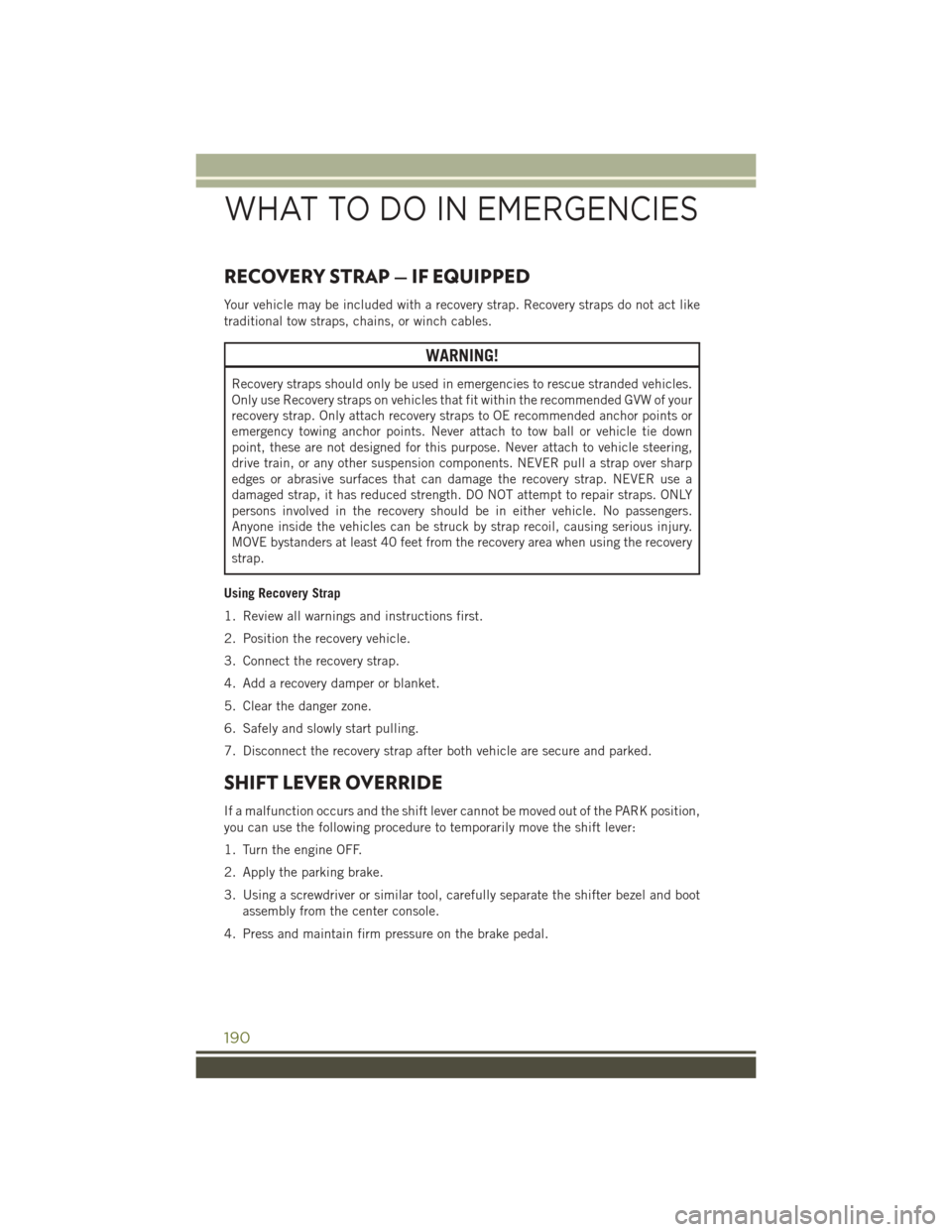
RECOVERY STRAP — IF EQUIPPED
Your vehicle may be included with a recovery strap. Recovery straps do not act like
traditional tow straps, chains, or winch cables.
WARNING!
Recovery straps should only be used in emergencies to rescue stranded vehicles.
Only use Recovery straps on vehicles that fit within the recommended GVW of your
recovery strap. Only attach recovery straps to OE recommended anchor points or
emergency towing anchor points. Never attach to tow ball or vehicle tie down
point, these are not designed for this purpose. Never attach to vehicle steering,
drive train, or any other suspension components. NEVER pull a strap over sharp
edges or abrasive surfaces that can damage the recovery strap. NEVER use a
damaged strap, it has reduced strength. DO NOT attempt to repair straps. ONLY
persons involved in the recovery should be in either vehicle. No passengers.
Anyone inside the vehicles can be struck by strap recoil, causing serious injury.
MOVE bystanders at least 40 feet from the recovery area when using the recovery
strap.
Using Recovery Strap
1. Review all warnings and instructions first.
2. Position the recovery vehicle.
3. Connect the recovery strap.
4. Add a recovery damper or blanket.
5. Clear the danger zone.
6. Safely and slowly start pulling.
7. Disconnect the recovery strap after both vehicle are secure and parked.
SHIFT LEVER OVERRIDE
If a malfunction occurs and the shift lever cannot be moved out of the PARK position,
you can use the following procedure to temporarily move the shift lever:
1. Turn the engine OFF.
2. Apply the parking brake.
3. Using a screwdriver or similar tool, carefully separate the shifter bezel and boot assembly from the center console.
4. Press and maintain firm pressure on the brake pedal.
WHAT TO DO IN EMERGENCIES
190
Page 193 of 236
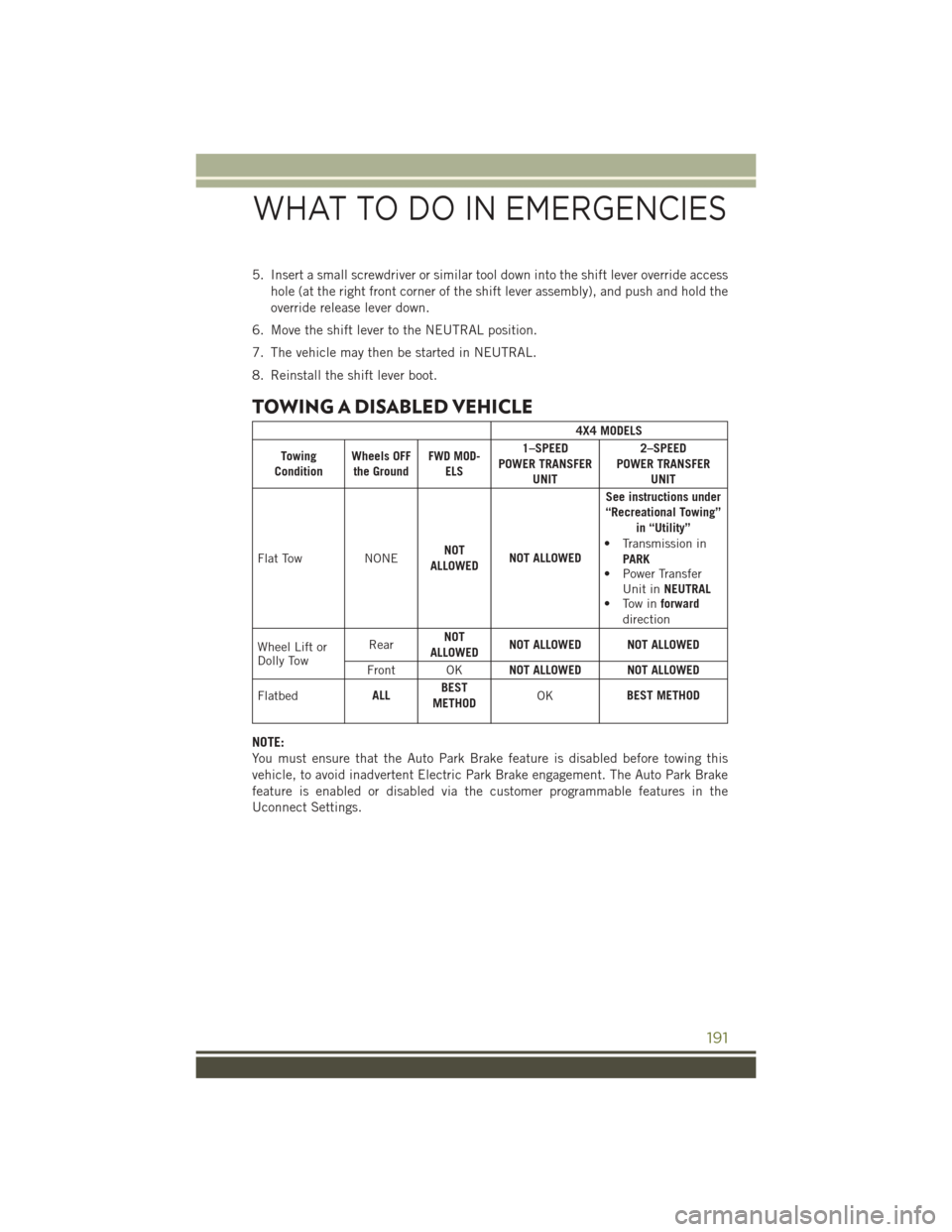
5. Insert a small screwdriver or similar tool down into the shift lever override accesshole (at the right front corner of the shift lever assembly), and push and hold the
override release lever down.
6. Move the shift lever to the NEUTRAL position.
7. The vehicle may then be started in NEUTRAL.
8. Reinstall the shift lever boot.
TOWING A DISABLED VEHICLE
4X4 MODELS
Towing
Condition Wheels OFF
the Ground
FWD MOD- ELS1–SPEED
POWER TRANSFER UNIT 2–SPEED
POWER TRANSFER UNIT
Flat Tow NONENOT
ALLOWED NOT ALLOWED See instructions under
“Recreational Towing” in “Utility”
• Transmission in
PARK
• Power Transfer
Unit in NEUTRAL
• Tow in forward
direction
Wheel Lift or
Dolly Tow Rear
NOT
ALLOWED NOT ALLOWED NOT ALLOWED
Front OK NOT ALLOWED NOT ALLOWED
Flatbed ALLBEST
METHOD OK
BEST METHOD
NOTE:
You must ensure that the Auto Park Brake feature is disabled before towing this
vehicle, to avoid inadvertent Electric Park Brake engagement. The Auto Park Brake
feature is enabled or disabled via the customer programmable features in the
Uconnect Settings.
WHAT TO DO IN EMERGENCIES
191
Page 194 of 236
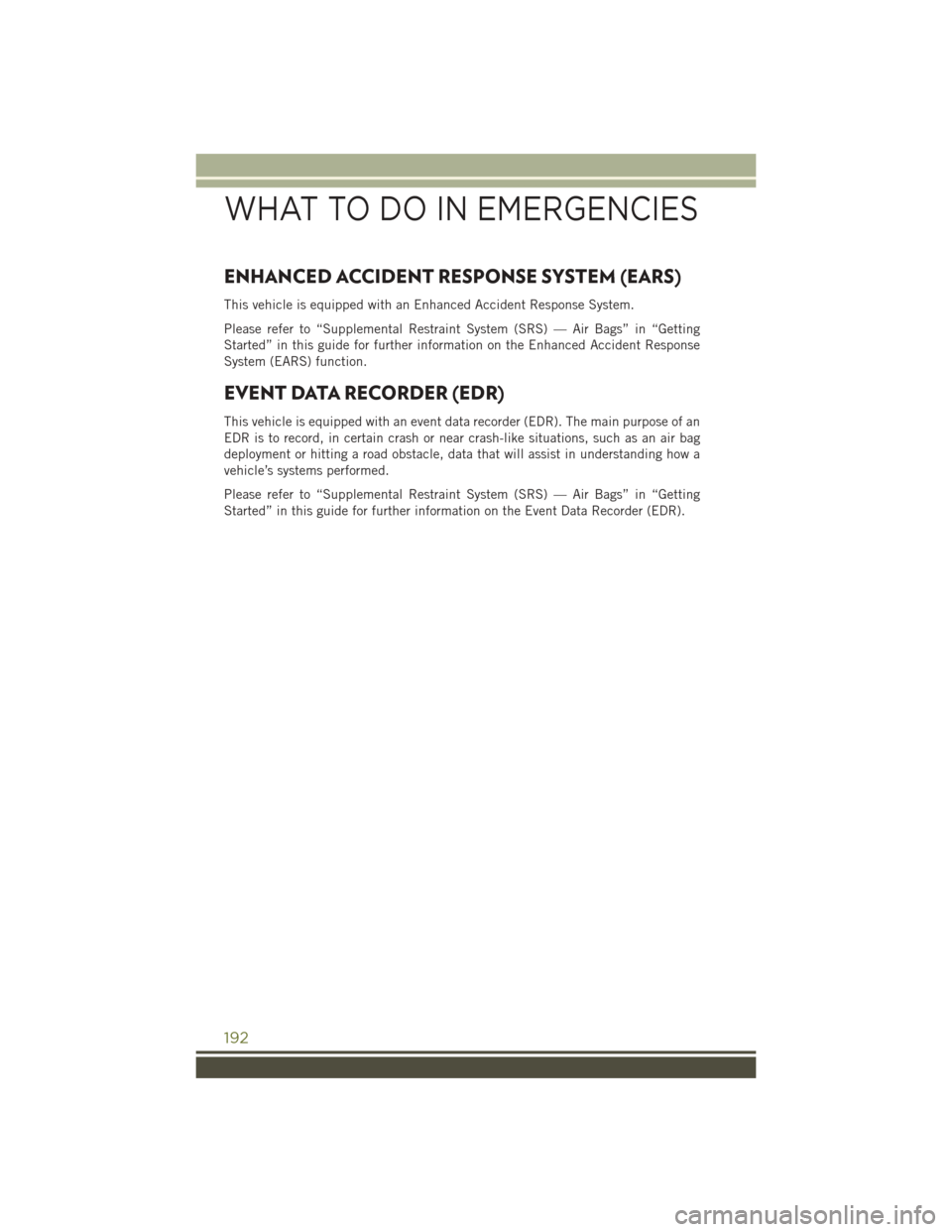
ENHANCED ACCIDENT RESPONSE SYSTEM (EARS)
This vehicle is equipped with an Enhanced Accident Response System.
Please refer to “Supplemental Restraint System (SRS) — Air Bags” in “Getting
Started” in this guide for further information on the Enhanced Accident Response
System (EARS) function.
EVENT DATA RECORDER (EDR)
This vehicle is equipped with an event data recorder (EDR). The main purpose of an
EDR is to record, in certain crash or near crash-like situations, such as an air bag
deployment or hitting a road obstacle, data that will assist in understanding how a
vehicle’s systems performed.
Please refer to “Supplemental Restraint System (SRS) — Air Bags” in “Getting
Started” in this guide for further information on the Event Data Recorder (EDR).
WHAT TO DO IN EMERGENCIES
192
Page 195 of 236
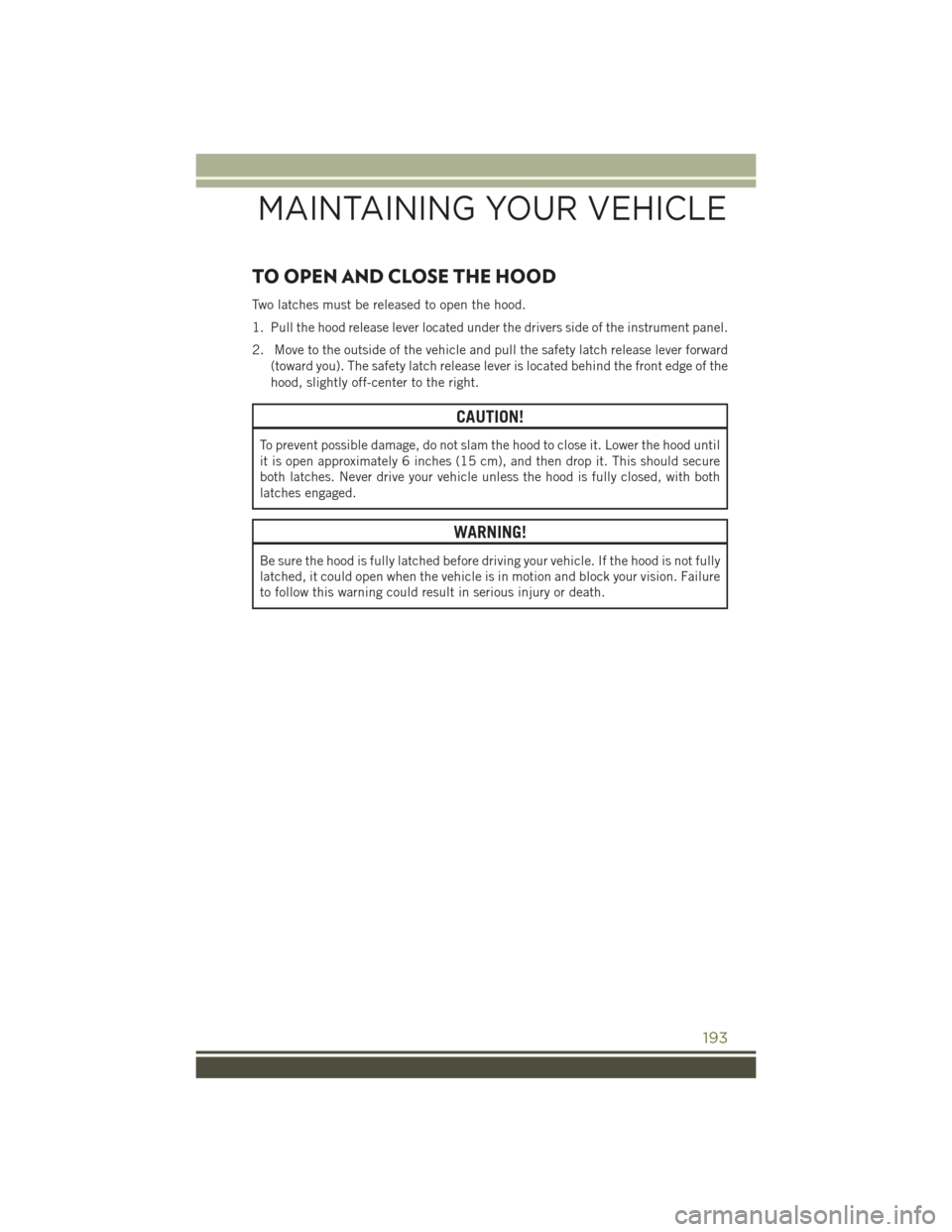
TO OPEN AND CLOSE THE HOOD
Two latches must be released to open the hood.
1. Pull the hood release lever located under the drivers side of the instrument panel.
2. Move to the outside of the vehicle and pull the safety latch release lever forward(toward you). The safety latch release lever is located behind the front edge of the
hood, slightly off-center to the right.
CAUTION!
To prevent possible damage, do not slam the hood to close it. Lower the hood until
it is open approximately 6 inches (15 cm), and then drop it. This should secure
both latches. Never drive your vehicle unless the hood is fully closed, with both
latches engaged.
WARNING!
Be sure the hood is fully latched before driving your vehicle. If the hood is not fully
latched, it could open when the vehicle is in motion and block your vision. Failure
to follow this warning could result in serious injury or death.
MAINTAINING YOUR VEHICLE
193
Page 196 of 236
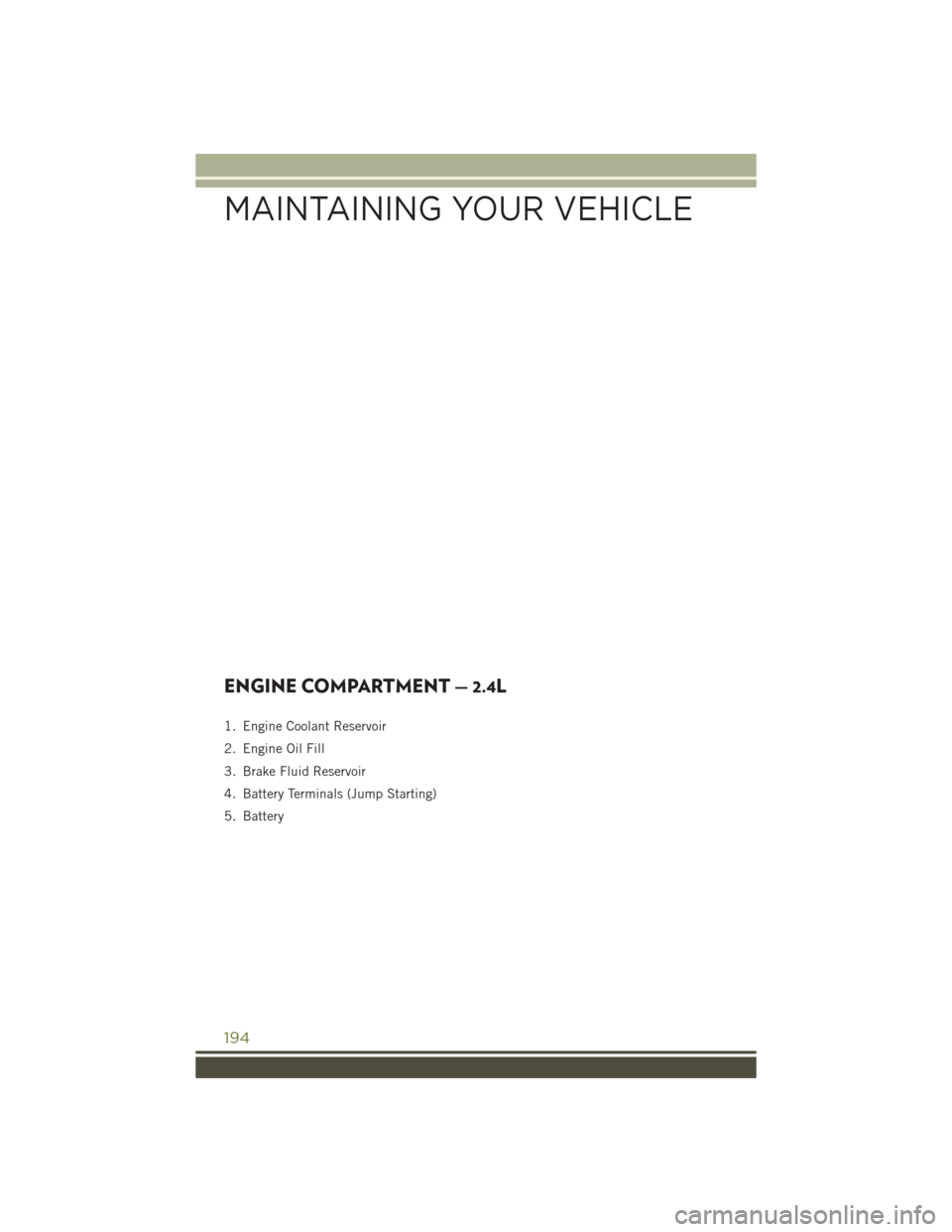
ENGINE COMPARTMENT — 2.4L
1. Engine Coolant Reservoir
2. Engine Oil Fill
3. Brake Fluid Reservoir
4. Battery Terminals (Jump Starting)
5. Battery
MAINTAINING YOUR VEHICLE
194
Page 197 of 236
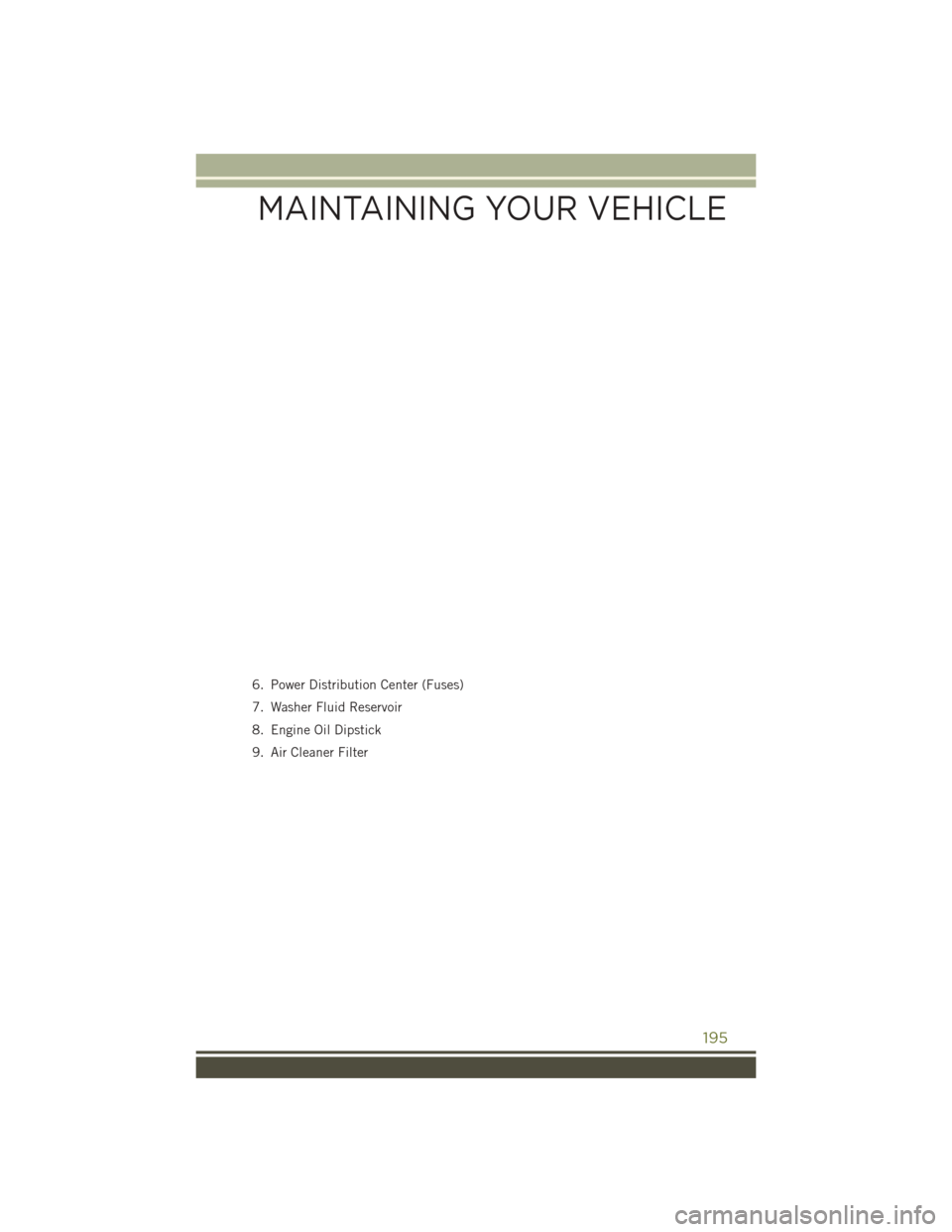
6. Power Distribution Center (Fuses)
7. Washer Fluid Reservoir
8. Engine Oil Dipstick
9. Air Cleaner Filter
MAINTAINING YOUR VEHICLE
195
Page 198 of 236
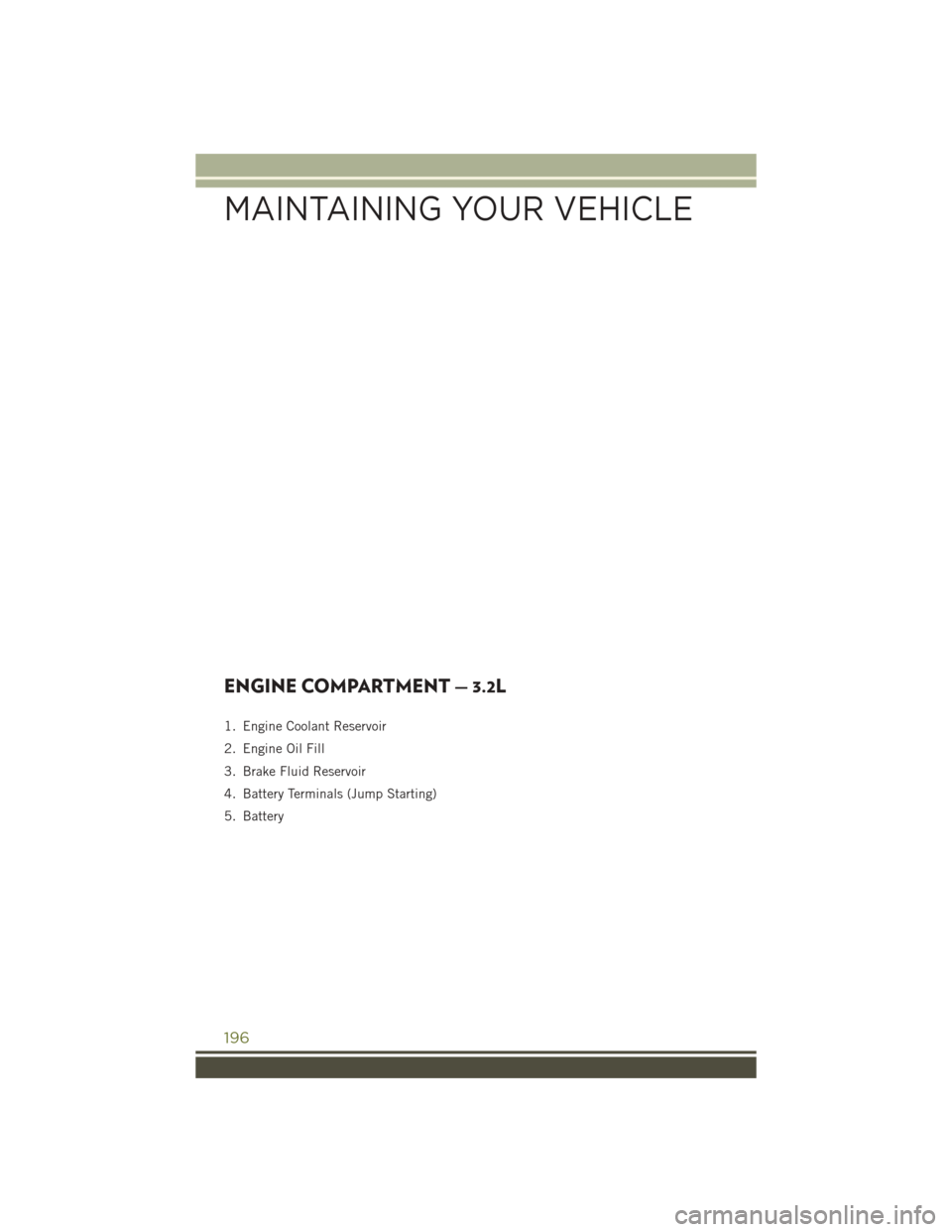
ENGINE COMPARTMENT — 3.2L
1. Engine Coolant Reservoir
2. Engine Oil Fill
3. Brake Fluid Reservoir
4. Battery Terminals (Jump Starting)
5. Battery
MAINTAINING YOUR VEHICLE
196
Page 199 of 236
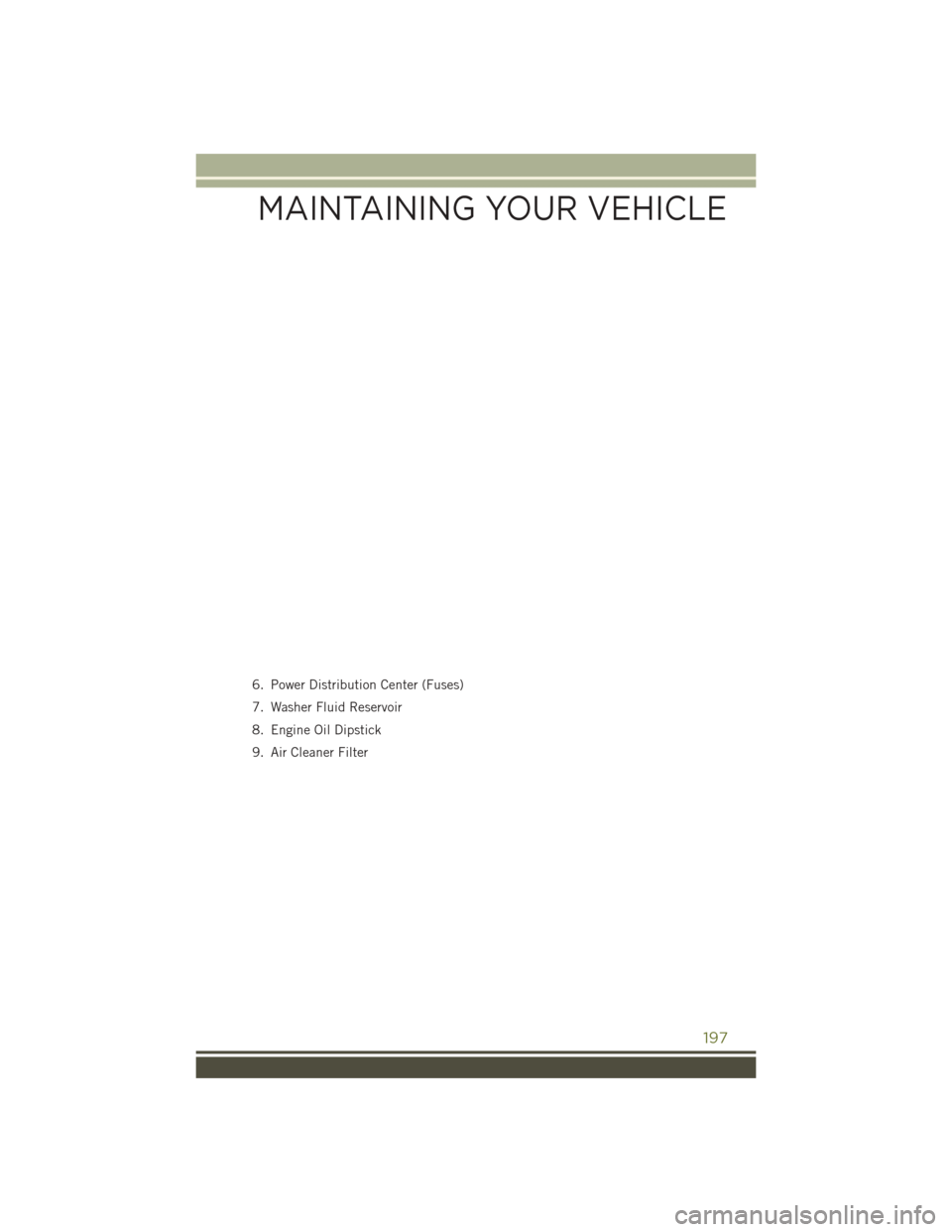
6. Power Distribution Center (Fuses)
7. Washer Fluid Reservoir
8. Engine Oil Dipstick
9. Air Cleaner Filter
MAINTAINING YOUR VEHICLE
197
Page 200 of 236
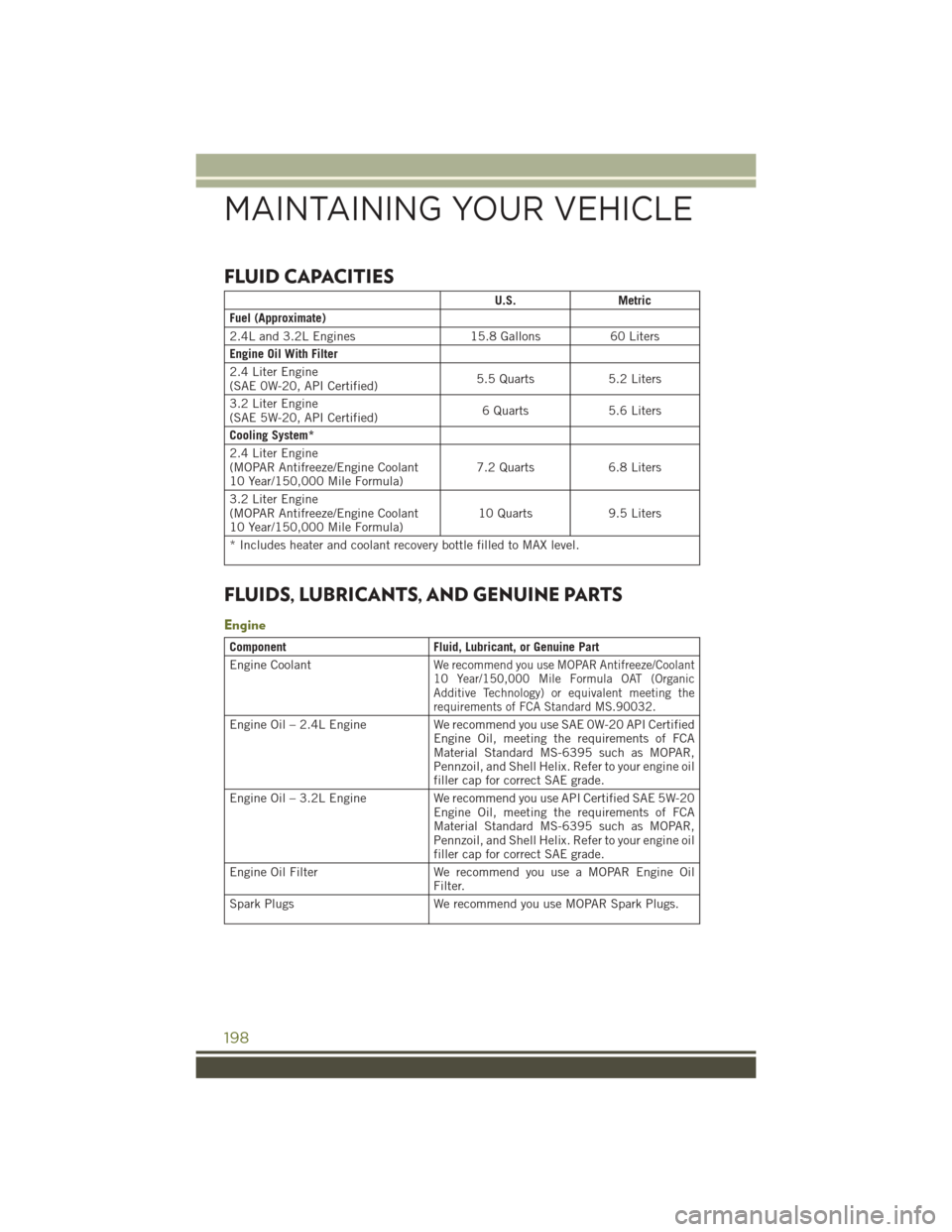
FLUID CAPACITIES
U.S.Metric
Fuel (Approximate)
2.4L and 3.2L Engines 15.8 Gallons60 Liters
Engine Oil With Filter
2.4 Liter Engine
(SAE 0W-20, API Certified) 5.5 Quarts
5.2 Liters
3.2 Liter Engine
(SAE 5W-20, API Certified) 6 Quarts
5.6 Liters
Cooling System*
2.4 Liter Engine
(MOPAR Antifreeze/Engine Coolant
10 Year/150,000 Mile Formula) 7.2 Quarts
6.8 Liters
3.2 Liter Engine
(MOPAR Antifreeze/Engine Coolant
10 Year/150,000 Mile Formula) 10 Quarts
9.5 Liters
* Includes heater and coolant recovery bottle filled to MAX level.
FLUIDS, LUBRICANTS, AND GENUINE PARTS
Engine
Component Fluid, Lubricant, or Genuine Part
Engine Coolant
We recommend you use MOPAR Antifreeze/Coolant
10 Year/150,000 Mile Formula OAT (Organic
Additive Technology) or equivalent meeting the
requirements of FCA Standard MS.90032.
Engine Oil – 2.4L Engine We recommend you use SAE 0W-20 API Certified
Engine Oil, meeting the requirements of FCA
Material Standard MS-6395 such as MOPAR,
Pennzoil, and Shell Helix. Refer to your engine oil
filler cap for correct SAE grade.
Engine Oil – 3.2L Engine We recommend you use API Certified SAE 5W-20
Engine Oil, meeting the requirements of FCA
Material Standard MS-6395 such as MOPAR,
Pennzoil, and Shell Helix. Refer to your engine oil
filler cap for correct SAE grade.
Engine Oil Filter We recommend you use a MOPAR Engine Oil
Filter.
Spark Plugs We recommend you use MOPAR Spark Plugs.
MAINTAINING YOUR VEHICLE
198